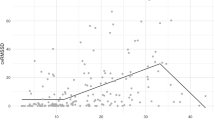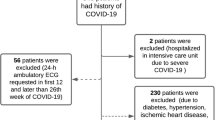Abstract
Heart rate variability (HRV) refers to the beat-to-beat variation of the cardiac cycle. Since heart rate is modulated on a beat-to-beat basis by the combined influence of the sympathetic and parasympathetic nervous system at the sinus node level, HRV has been considered an indirect biomarker of cardiac autonomic control and widely exploited for the assessment of autonomic function in many pathological subjects. This focus article summarizes the main findings derived from HRV analysis applied to 24‑h Holter monitoring in both cardiac and non-cardiac diseases as well as in physiological conditions in the healthy population. Even if the prognostic role of HRV indices is well recognized and its use ever more widespread, its implementation in the diagnostic and prognostic processes in routine clinical practice remains limited. Several reasons for these limitations can be identified: first the lack of reliable reference values, and secondly, the low specificity of HRV indices in particular when considering the constant evolution of clinical practice and therapeutic approaches, making it difficult to refer to a specific and stable combination of clinical and HRV markers. Therefore, the clinical use of HRV should be further investigated. Finally, HRV represents a substantial tool for investigating the physiological conditions in healthy people that can have important implications in primary prevention and the understanding of gender differences, as well as in sport and occupational medicine.
Zusammenfassung
Der Begriff Herzfrequenzvariabilität (HRV [„heart rate variability“]) beschreibt die Schlag-zu-Schlag-Variationen des Herzzyklus. Da die Herzfrequenz auf Schlag-zu-Schlag-Basis durch den kombinierten Einfluss des sympathischen und parasympathischen Nervensystems auf Sinusknotenebene reguliert wird, wurde die HRV als indirekter Biomarker der kardialen autonomen Kontrolle angesehen und in vielen pathologischen Themenbereichen zur Bewertung der autonomen Funktion genutzt. Im vorliegenden Beitrag sind die HRV-Hauptbefunde zusammengefasst, die aus einer Analyse von 24-h-Holter-Überwachungen stammen, die sowohl bei Menschen mit kardialen als auch nichtkardialen Erkrankungen sowie unter physiologischen Bedingungen in einer gesunden Population durchgeführt wurden. Auch wenn die prognostische Rolle der HRV-Indizes allgemein anerkannt ist und ihr Einsatz immer weiter verbreitet wird, bleibt ihre Implementierung in die diagnostischen und prognostischen klinischen Routineprozesse begrenzt. Hierfür lassen sich verschiedene Gründe anführen: zum einen das Fehlen verlässlicher Referenzwerte, zum anderen die niedrige Spezifität der HRV-Indizes, insbesondere unter Berücksichtigung der fortwährenden Weiterentwicklung der klinischen Praxis und therapeutischen Möglichkeiten, die es schwierig machen, eine spezifische und stabile Kombination klinischer und herzfrequenzassoziierter Marker zu benennen. Deshalb sollte der klinische Einsatz der HRV weiter untersucht werden. Schließlich stellt sie auch ein wesentliches Instrument zur Untersuchung der physiologischen Bedingungen bei gesunden Menschen dar, das wesentliche Auswirkungen auf die Primärprävention und das Verständnis von geschlechtsspezifischen Unterschieden, ebenso auch für die Sport- und Arbeitsmedizin haben kann.
Similar content being viewed by others
Literatur
Hon EH, Lee ST (1965) Electronic evaluations of the fetal heart rate patterns preceding fetal death, further observations. Am J Obstet Gynecol 87:814–826
Akselrod S, Gordon D, Ubel FA, Shannon DC, Berger AC, Cohen RJ (1981) Power spectrum analysis of heart rate fluctuation: a quantitative probe of beat-to-beat cardiovascular control. Science 213:220–222
Pomeranz B, Macaulay RJ, Caudill MA et al (1985) Assessment of autonomic function in humans by heart rate spectral analysis. Am J Physiol 248:H151–3
Malik M, Hnatkova K, Huikuri HV, Lombardi F, Schmidt G, Zabel M (2019) Rebuttal. J Physiol 597:2603–2604
Task Force of the European Society of Cardiology and the North American Society of Pacing and Electrophysiology (1996) Heart rate variability. Standards of measurement, physiological interpretation, and clinical use. Eur Heart J 17:354–381
La Rovere MT, Pinna GD, Maestri R et al (2003) Short-term heart rate variability strongly predicts sudden cardiac death in chronic heart failure patients. Circulation 107:565–557
Dalla Vecchia LA, De Maria B, Cassetti G et al (2021) How the first years of motherhood impact the cardiac autonomic profile of female healthcare professionals: a study by heart rate variability analysis. Sci Rep 11:8161–8021
Sassi R, Cerutti S, Lombardi F et al (2015) Advances in heart rate variability signal analysis: joint position statement by the e‑cardiology ESC working group and the European heart rhythm association co-endorsed by the asia pacific heart rhythm society. Europace 17:1341–1353
Ernst G (2017) Hidden signals-the history and methods of heart rate variability. Front Public Health 5:26
Steinberg JS, Varma N, Cygankiewicz I et al (2017) 2017 ISHNE-HRS expert consensus statement on ambulatory ECG and external cardiac monitoring/telemetry. Heart Rhythm 14:e55–e96
Lombardi F, Stein PK (2011) Origin of heart rate variability and turbulence: an appraisal of autonomic modulation of cardiovascular function. Front Physiol 2:95
Malik M, Hnatkova K, Huikuri HV, Lombardi F, Schmidt G, Zabel M (2019) Crosstalk proposal: heart rate variability is a valid measure of cardiac autonomic responsiveness. J Physiol 597:2595–2598
Porta A, Faes L, Mase M et al (2007) An integrated approach based on uniform quantization for the evaluation of complexity of short-term heart period variability: application to 24 h Holter recordings in healthy and heart failure humans. Chaos 17:15117
Porta A, D’addio G, Bassani T, Maestri R, Pinna GD (2009) Assessment of cardiovascular regulation through irreversibility analysis of heart period variability: a 24 hours Holter study in healthy and chronic heart failure populations. Philos Trans A Math Phys Eng Sci 367:1359–1375
Kobayashi M, Musha T (1982) 1/f fluctuation of heartbeat period. IEEE Trans Biomed Eng 29:456–457
Peng CK, Havlin S, Stanley HE, Goldberger AL (1995) Quantification of scaling exponents and crossover phenomena in nonstationary heartbeat time series. Chaos 5:82–87
Malliani A, Pagani M, Lombardi F, Cerutti S (1991) Cardiovascular neural regulation explored in the frequency domain. Circulation 84:482–492
De Maria B, Bari V, Sgoifo A et al (2019) Concomitant evaluation of heart period and QT interval variability spectral markers to typify cardiac control in humans and rats. Front Physiol 10:1478
Lombardi F, Huikuri H, Schmidt G, Malik M, e‑Rhythm Study Group of European Heart Rhythm Association (2018) Short-term heart rate variability: easy to measure, difficult to interpret. Heart Rhythm 15:1559–1560
Valencia JF, Porta A, Vallverdu M et al (2009) Refined multiscale entropy: application to 24‑h Holter recordings of heart period variability in healthy and aortic stenosis subjects. IEEE Trans Biomed Eng 56:2202–2213
Maestri R, Pinna GD, Accardo A et al (2007) Nonlinear indices of heart rate variability in chronic heart failure patients: redundancy and comparative clinical value. J Cardiovasc Electrophysiol 18:425–433
Bauer A, Malik M, Schmidt G et al (2008) Heart rate turbulence: standards of measurement, physiological interpretation, and clinical use: international society for Holter and noninvasive electrophysiology consensus. J Am Coll Cardiol 52:1353–1365
Kleiger RE, Miller JP, Bigger JT, Moss AJ (1987) Decreased heart rate variability and its association with increased mortality after acute myocardial infarction. Am J Cardiol 59:256–262
La Rovere MT, Bigger JT, Marcus FI, Mortara A, Schwartz PJ (1998) Baroreflex sensitivity and heart-rate variability in prediction of total cardiac mortality after myocardial infarction. ATRAMI (autonomic tone and reflexes after myocardial infarction) investigators. Lancet 351:478–448
Huikuri HV, Stein PK (2012) Clinical application of heart rate variability after acute myocardial infarction. Front Physiol 3:41
Makikallio TH, Hoiber S, Kober L et al (1999) Fractal analysis of heart rate dynamics as a predictor of mortality in patients with depressed left ventricular function after acute myocardial infarction. TRACE investigators. TRAndolapril Cardiac Evaluation. Am J Cardiol 83:836–839
Makikallio TH, Barthel P, Schneider R et al (2005) Prediction of sudden cardiac death after acute myocardial infarction: role of Holter monitoring in the modern treatment era. Eur Heart J 26:762–769
Nolan J, Batin PD, Andrews R et al (1998) Prospective study of heart rate variability and mortality in chronic heart failure: results of the United Kingdom heart failure evaluation and assessment of risk trial (UK-heart). Circulation 98:1510–1516
Galinier M, Pathak A, Fourcade J et al (2000) Depressed low frequency power of heart rate variability as an independent predictor of sudden death in chronic heart failure. Eur Heart J 21:475–482
La Rovere MT, Pinna GD, Maestri R et al (2012) Autonomic markers and cardiovascular and arrhythmic events in heart failure patients: still a place in prognostication? Data from the GISSI-HF trial. Eur J Heart Fail 14:1410–1419
Guzzetti S, La Rovere MT, Pinna GD et al (2005) Different spectral components of 24 h heart rate variability are related to different modes of death in chronic heart failure. Eur Heart J 26:357–362
Guzzetti S, Dassi S, Pecis M et al (1991) Altered pattern of circadian neural control of heart period in mild hypertension. J Hypertens 9:831–838
Bosone D, Fogari R, Ramusino MC et al (2017) Ambulatory 24‑h ECG monitoring and cardiovascular autonomic assessment for the screening of silent myocardial ischemia in elderly type 2 diabetic hypertensive patients. Heart Vessels 32:507–513
Roche F, Pichot V, Sforza E et al (2003) Predicting sleep apnoea syndrome from heart period: a time-frequency wavelet analysis. Eur Respir J 22:937–942
Dalla Vecchia L, De Maria B, Marinou K et al (2015) Cardiovascular neural regulation is impaired in amyotrophic lateral sclerosis patients. A study by spectral and complexity analysis of cardiovascular oscillations. Physiol Meas 36:659–670
Kiyono K, Hayano J, Kwak S, Watanabe E, Yamamoto Y (2012) Non-gaussianity of low frequency heart rate variability and sympathetic activation: lack of increases in multiple system atrophy and Parkinson disease. Front Physiol 3:34
Jain S, Ton TG, Perera S et al (2012) Cardiovascular physiology in premotor Parkinson’s disease: a neuroepidemiologic study. Mov Disord 27:988–995
Kim JS, Lee SH, Oh YS et al (2016) Cardiovascular autonomic dysfunction in mild and advanced parkinson’s disease. J Mov Disord 9:97–103
Sammito S, Bockelmann I (2016) Reference values for time- and frequency-domain heart rate variability measures. Heart Rhythm 13:1309–1316
Bauer A, Camm AJ, Cerutti S et al (2017) Reference values of heart rate variability. Heart Rhythm 14:302–303
Accardo A, Merlo M, Silveri G et al (2021) Influence of ageing on circadian rhythm of heart rate variability in healthy subjects. J Cardiovasc Med (Hagerstown) 22:405–413
Kiss O, Sydo N, Vargha P et al (2016) Detailed heart rate variability analysis in athletes. Clin Auton Res 26:245–252
Jarczok MN, Jarczok M, Mauss D et al (2013) Autonomic nervous system activity and workplace stressors—a systematic review. Neurosci Biobehav Rev 37:1810–1823
Jensen MT, Treskes WT, Caiani EG et al (2021) ESC working group on e‑cardiology position paper: use of commercially available wearable technology for heart rate and activity tracking in primary and secondary cardiovascular prevention. Eur Heart J Digit Health. https://doi.org/10.1093/ehjdh/ztab011
Author information
Authors and Affiliations
Corresponding author
Ethics declarations
Conflict of interest
B. De Maria, L.A. Dalla Vecchia, A. Porta and M.T. La Rovere declare that they have no competing interests.
For this article no studies with human participants or animals were performed by any of the authors. All studies performed were in accordance with the ethical standards indicated in each case.
Additional information

QR-Code scannen & Beitrag online lesen
Rights and permissions
About this article
Cite this article
De Maria, B., Dalla Vecchia, L.A., Porta, A. et al. Autonomic dysfunction and heart rate variability with Holter monitoring: a diagnostic look at autonomic regulation. Herzschr Elektrophys 32, 315–319 (2021). https://doi.org/10.1007/s00399-021-00780-5
Received:
Accepted:
Published:
Issue Date:
DOI: https://doi.org/10.1007/s00399-021-00780-5




